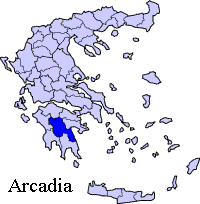|
|
Vastas, a village of the Megalopolis Municipality, in the Arcadia prefecture of Peloponnesos, Greece. Population 147 in 2001 Vastas, a remote village of Arcadia is best known for its "miracle church" of Saint Theodora, who was an 11th century Byzantine citizen. When the area was raided by bandits, Theodora was determined to help defend her village, but as a woman it was unthinkable to do so. Not to be deterred, Theodora secretly disguised herself as a male soldier in order to join the defense. Unfortunately, Theodora did not survive, and as she lay dying she uttered the following words: ''"Let my body become a church The villagers, moved by her bravery and her untimely demise, built a church at the site of her grave. Legend has it that a local river re-routed to pass directly under the church. Eventually, trees sprouted from the roof of the church, the roots of which are not visible under the roof and neither inside or outside the church. Currently the church has 17 enormous holly and maple trees growing on its roof. Most of them are taller than 30 meters. Saint (Aghia) Theodora, has become one of the most important saints of the Greek Orthodox Church and the site has become important for religious pilgrims and site-seers alike.
Agia Theodora church, Vasta, with maple trees growing on its roof. [Source] The mystery of the trees Researchers from the University of Patras in Greece have studied the structure and have the following comments: Many stories have seen the light of publication for the small church of Saint Theodora of particular religious importance, mainly related to its creation, the Saint that has given him her name and its story in general that also involves a "miracle". The building of the small church, visited each year by many believers is of the Byzantine era and besides the jurisdiction of the Church it is also under that of the Ministry of Culture as a Byzantine Monument. The geophysical team of the University of Patras tried to add to the restoration of this preserved building. The problem was directly connected to the "miracle" that takes place there and the myth that is spread around involving the creation of the small church and is as follows: seventeen large trees and several smaller have grown on the roof of the building. Their roots are not visible under the few centimeters roof and neither inside or outside the church. The whole building is of course, under pressure due to this large load and there have been several reconstruction interventions during its life. Those non-professional interventions resulted at destroying the architecture of the church. The problem that had to be dealt with according to the trees on the top, was to find out where their roots were directed, without provoking the religious feeling of the church people and the clergymen that were our "sleepless guardians" throughout the entire survey. After an onsite estimation of the situation it was decided that the high-frequency georadar would be used on the walls of the building together with electrical tomography with very small electrodes, so as to have a double check on the methodology. The results of the investigation threw ample light to the mystery and gave the Direction of Restoration of Byzantine and After Byzantine Monuments all the answers they needed to proceed safely to the restoration of the Church of Saint Theodora. It was proved that the roots follow the gaps existing inside the side stonewall creating repulsion stresses between the stones and thus they reach the ground. This leads to the creation of a net of roots that reinforces the building from a static point of view opposing the roof load but also destroying the stonewalls. It was also proved that the south wall is almost intact while there seems to be a particular void in the north wall.
Retrieved from "http://en.wikipedia.org"
 |
||||||||||||||



